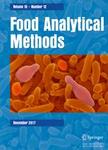版权所有:内蒙古大学图书馆 技术提供:维普资讯• 智图
内蒙古自治区呼和浩特市赛罕区大学西街235号 邮编: 010021

作者机构:Univ Sao Paulo Inst Quim Dept Quim Fundamental Ave Prof Lineu Prestes 748 BR-05508000 Sao Paulo SP Brazil Agilent Technol Brazil Alameda Araguaia 1142 BR-06455000 Barueri SP Brazil
出 版 物:《FOOD ANALYTICAL METHODS》 (食品分析法)
年 卷 期:2019年第12卷第7期
页 面:1684-1692页
核心收录:
学科分类:0832[工学-食品科学与工程(可授工学、农学学位)] 08[工学]
基 金:FAPESP [2012/06642-1] CNPq [304415/2013-8] Fundacao de Amparo a Pesquisa do Estado de Sao Paulo (FAPESP) [12/06642-1] Funding Source: FAPESP
主 题:Capillary electrophoresis Tandem mass spectrometry Multiresidue pesticide analysis QuEChERS Corn
摘 要:The development and validation of a capillary electrophoresis-tandem mass spectrometry method for the determination of nine pesticides residues in corn samples is presented. The residues of thiabendazole, aminocarb, imazalil, atrazine, metazachlor, metoxuron, carbofuran, metosulam, and imazapyr have been extracted from corn samples using QuEChERS based extraction procedure. The optimal separation of investigated pesticides was achieved in less than 6 min with 0.1 mol L-1 formic acid (pH 2.4) as the background electrolyte using a poly(vinyl alcohol)-coated capillary. The coefficient of determination (r(2)), in the range of 5 to 200 g L-1, were greater than 0.995. Recoveries ranged from 70% to 110%. Relative standard deviations were lower than 7.8%. The limits of detection (LODs) ranged from 0.03 to 0.28 g kg(-1), while the limits of quantitation (LOQs) ranged from 0.10 to 0.93 g kg(-1), which are several times lower than the established maximum residue limits. These results suggest that the method attends the international legislation for all the analyzed pesticides in corn and that it has the potential to be successfully applied to other food matrices.